+Search query
-Structure paper
| Title | Constructing protein polyhedra via orthogonal chemical interactions. |
|---|---|
| Journal, issue, pages | Nature, Vol. 578, Issue 7793, Page 172-176, Year 2020 |
| Publish date | Jan 22, 2020 |
 Authors Authors | Eyal Golub / Rohit H Subramanian / Julian Esselborn / Robert G Alberstein / Jake B Bailey / Jerika A Chiong / Xiaodong Yan / Timothy Booth / Timothy S Baker / F Akif Tezcan /  |
| PubMed Abstract | Many proteins exist naturally as symmetrical homooligomers or homopolymers. The emergent structural and functional properties of such protein assemblies have inspired extensive efforts in ...Many proteins exist naturally as symmetrical homooligomers or homopolymers. The emergent structural and functional properties of such protein assemblies have inspired extensive efforts in biomolecular design. As synthesized by ribosomes, proteins are inherently asymmetric. Thus, they must acquire multiple surface patches that selectively associate to generate the different symmetry elements needed to form higher-order architectures-a daunting task for protein design. Here we address this problem using an inorganic chemical approach, whereby multiple modes of protein-protein interactions and symmetry are simultaneously achieved by selective, 'one-pot' coordination of soft and hard metal ions. We show that a monomeric protein (protomer) appropriately modified with biologically inspired hydroxamate groups and zinc-binding motifs assembles through concurrent Fe and Zn coordination into discrete dodecameric and hexameric cages. Our cages closely resemble natural polyhedral protein architectures and are, to our knowledge, unique among designed systems in that they possess tightly packed shells devoid of large apertures. At the same time, they can assemble and disassemble in response to diverse stimuli, owing to their heterobimetallic construction on minimal interprotein-bonding footprints. With stoichiometries ranging from [2 Fe:9 Zn:6 protomers] to [8 Fe:21 Zn:12 protomers], these protein cages represent some of the compositionally most complex protein assemblies-or inorganic coordination complexes-obtained by design. |
 External links External links |  Nature / Nature /  PubMed:31969701 / PubMed:31969701 /  PubMed Central PubMed Central |
| Methods | EM (single particle) / X-ray diffraction |
| Resolution | 1.4 - 2.6 Å |
| Structure data | EMDB-20212, PDB-6ovh: 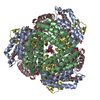 PDB-6ot4: 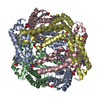 PDB-6ot7: 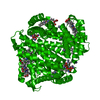 PDB-6ot8: 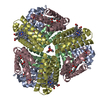 PDB-6ot9: |
| Chemicals | 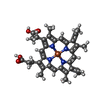 ChemComp-HEC: 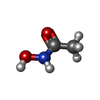 ChemComp-HAE:  ChemComp-FE:  ChemComp-ZN:  ChemComp-HOH: 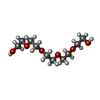 ChemComp-1PE: |
| Source |
|
 Keywords Keywords | METAL BINDING PROTEIN / Supramolecular assembly / protein cage / bimetallic / metal binding / hydroxamic acid |
 Movie
Movie Controller
Controller Structure viewers
Structure viewers About Yorodumi Papers
About Yorodumi Papers






